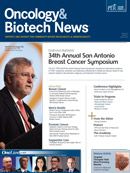Publication
Article
Oncology & Biotech News
Concurrent Zoledronic Acid Is Preferable in Letrozole-Treated Postmenopausal Patients With Breast Cancer
Author(s):
Upfront zoledronic acid is superior to delayed use in postmenopausal women with early breast cancer who are being treated with the aromatase inhibitor letrozole.
Adam Brufsky, MD, PhD
Upfront zoledronic acid is superior to delayed use in postmenopausal women with early breast cancer who are being treated with the aromatase inhibitor (AI) letrozole, according to 5-year results of the Z-FAST study. The data showed that upfront zoledronic acid significantly increases bone mineral density (BMD), and that long-term co-administration of letrozole and zoledronic acid is well tolerated.
Adam M. Brufsky, MD, PhD, with Magee-Womens Hospital in Pittsburgh, Pennsylvania and colleagues randomized 602 women receiving adjuvant letrozole to 5 years of treatment with zoledronic acid (4 mg intravenously every 6 mo) initiated simultaneously with letrozole or initiated with a decrease in T score to ≤2 or the occurrence of clinical nontraumatic fracture.
Adjuvant AI therapy given either alone or sequentially after tamoxifen in postmenopausal women with early breast cancer is associated with increasing bone loss and fractures, which may develop within the first year of AI therapy and continue throughout the entire course of AI therapy. Even so, AIs are the most popular adjuvant treatment in postmenopausal women with early, hormone receptor-positive breast cancer because they improve survival more than tamoxifen. Postmenopausal women frequently need long-term AI therapy, and the availability of good strategies to thwart bone loss is thereby essential.
Study participants were postmenopausal and had early, hormone receptor-positive breast cancer. The primary outcome measure was the change in lumbar spine (LS) BMD at month 12.
Results showed that regardless of baseline T score, chemotherapy status, or the presence of risk factors, there were significant and progressive increases in LS and total hip BMD throughout the 5-year study in women randomized to upfront zoledronic acid. On the other hand, significant BMD reductions occurred with delayed administration. At month 61, the adjusted mean difference in LS and total hip BMDs between the upfront and delayed groups was 8.9% and 6.7%, respectively (P <.0001, for both). Over time, however, the rate of BMD decline in the delayed group slowed, which probably occurred because more delayed patients received zoledronic acid by the end of the study, the authors said.
A post-hoc analysis revealed increases in LS BMD of about 4% from baseline in delayed patients who received zoledronic acid by month 60 despite the delay in therapy.
The long-term use of letrozole and zoledronic acid was generally well tolerated. There were no confirmed cases of osteonecrosis of the jaw during the study and only 1 case of renal impairment related to the study drug.
Brufsky and associates pointed out that zoledronic acid’s favorable effects on BMD in patients with breast cancer receiving AI therapy are thought to result from the agent’s ability to block estrogen deprivation-associated osteoclast-mediated bone resorption. They noted that metabolic bone marker data favoring upfront zoledronic acid bolster this hypothesis.
Brufsky AM, Harker WG, Beck JT, et al. Final 5-year results of Z-FAST trial: adjuvant zoledronic acid maintains bone mass in postmenopausal breast cancer patients receiving letrozole [published online ahead of print October 10, 2011]. Cancer. 2011. doi: 10.1002/cncr.26313.










